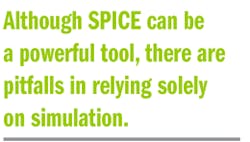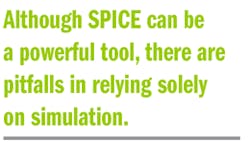AC Rectifier Bulk Capacitor Selection with Analysis+SPICE
[For a copy of this article in PDF format, which displays figures and equations,
Requires Adobe Acrobat Reader,
.]
Although SPICE can be a powerful tool, there are pitfalls in relying solely on simulation. To avoid unpleasant surprises, it's imperative that a SPICE simulation be anchored to a detailed understanding of the circuit. Ideally, this includes a thorough analysis, capped off by testing.
A previous article in Power Electronics Technology by Christophe Basso1 explained how, starting with a desired capacitor ripple voltage and defined load power, you can use SPICE to select the optimized value of the input rectifier circuit's filter capacitor. However, Ed Walker of Design/Analysis Consultants Inc. noted that this argument is not completely sound, and the defined SPICE approach may actually result in capacitor degradation or even explosion. That's because the selection of bulk capacitance is primarily determined by the RMS ripple current rating of the capacitor, not the ripple voltage. When ripple current is considered, the required capacitance typically will be much larger than when selection is based only on ripple voltage.
Creative Conflict
Although the previous article was intended to demonstrate the flexibility of SPICE for a common practical application, it should have included a discussion of the importance of capacitor ripple current. Thus, simply simulating a design without knowing the equations behind the circuit would inevitably lead to a poor-performing, unreliable device.
When the SPICE results of an ac rectification circuit with low source impedance were reviewed, we found that the charging current had a sawtooth shape, rather than the rectangular pulse that is often assumed. Was the conventional analysis assumption incorrect? Or was the sawtooth in Basso's example an unusual case, with the more typical waveform being rectangular?
Such conflict between analysis and simulation/test results is a typical and highly beneficial result of a thorough worst-case analysis design process, prodding the designer/analyst to resolve such discrepancies. In this case, the need for further analysis led us back to the past.
Augmenting Schade's Curves Using Analysis
The basic characteristics of rectifier circuits were determined by O.H. Schade back in 1943, as documented in his classic article, Analysis of Rectifier Operation (Proc. IRE, Vol. 31, No. 7, July 1943). “Schade's Curves,” as they are known, present a wide range of rectifier performance in graphical form, including the effects of source impedance down to 0.02% of load impedance. However, Schade did not include curves of bulk capacitor ripple current. Therefore Walker performed an analysis of the bridge rectifier circuit to determine its capacitor RMS ripple amps for Rs/R = 0.02%, and also for Rs/R = 0.001%, since some modern designs may have extremely low source impedance. For circuit design purposes, output voltage and ripple were also computed. The analysis was performed using the Design Master™ analysis software (Professional Edition). Results are presented in graphical form in Figs. 2 and 3.
To see if you're using a properly rated bulk capacitor, simply measure your rectifier circuit's maximum ripple (e.g., at minimum load impedance and maximum Vac). Using the top graph, locate the percent ripple value on the left Y-axis and find the intersection with the ripple curve. Move up or down vertically and locate the intersection with the RMS amps curves, using the higher curve (lowest Rs/R) as applicable to your design. Now, move horizontally to find the rms factor on the right Y-axis. Multiply the factor times your max load amps. The result is the RMS ripple amps rating that you should have used for the bulk capacitor, based on input considerations. You'll also have to add any contribution due to RMS load amps:
ICRMS(total) = SQR(ICRMS(input)^2 + ICRMS(load)^2).
Example: Max ripple is measured to be ˜ 5.5%. This intersects the ripple curve at nωCR = 100. Moving up vertically, the RMS intersection occurs at ˜ 3.3. Assume that you have a max load current of 5 A. Therefore, the bulk capacitor should have a ripple amps rating of 5 3 × 3.3 = 16.5ARMS. Add RMS load amps, if any, as described above.
New Designs
-
Select nωCR for the desired maximum output percent ripple. For example, for max peak-peak ripple = 10% of peak ac voltage, the ripple point occurs for nωCR ˜ 50.
-
From nωCR, solve for the required bulk capacitor, using the minimum value of load resistance R. For example, if the load resistance is 100 V and the ac frequency is 60 Hz, then:
C = 50/(nωR) = 50/(2*2*Pi*60*100) = 663 µF
-
Select a standard value of C and recompute nωCR. Let's assume a 680-µF capacitor was selected. From the capacitor RMS amps graph, maximum ripple amps occurs for maximum C, so use the maximum tolerance for the capacitor. Assuming 20%,
nωCR = 2*2*Pi*60*(680E-6*1.2)*100 ˜ 62
-
Find the point where the new value of nωCR intersects RMS amps line to determine the bulk capacitance ripple amps factor. In this example, the lines for Rs/R = 0.001% and 0.02% overlap, and the RMS value is
ICRMS/Idc for nωCR = 62 is ˜ 2.9 A per output dc amp
-
Using the Dc Output Voltage graph, find the intersection of the curve at nωCR. For nωCR = 62, the intersection is at ˜ 0.97. Therefore, Vdc will be 97% of the AC source peak, less rectifier drop Vf. The worst case will be for maximum Vac and minimum Vf. Assuming Vac = 120 Vac max = 132 Vac and Vf min = 1Vx 2, then
Vdc = 0.97*(1.414*Vacmax-Vfmin) = 0.97*(1.414*132-2) = 179 V
-
Divide Vdc by the minimum load ohms to get the load amps:
Idc = Vdc/Rmin = 179/100 = 1.79 A
-
Multiply Idc times the ripple amp factor from Step 4 to get the required RMS ripple amps rating for the bulk capacitor:
ICRMS = Idc*ICRMS/Idc = 1.79*2.9 = 5.2 ARMS
Note: If you can't find a capacitor with the desired ripple amps and want to select a larger capacitor with a higher ripple rating, you'll need to recompute using the new C value for nωCR, because as C increases, ICRMS also increases.
-
After using the curves to find the value of RMS ripple due to the ac input charging current, don't forget to include the effects of any load-generated ripple current; e.g. switchmode power supply. The total capacitor RMS ripple amps requirement will be:
ICrms(total) = SQR(ICrms(input)^2+ ICrms(load)^2)
Results Review
It's interesting to observe that a rectangular charging pulse doesn't really occur. For low source impedances (Rs/R = 0.001%) and with a high value of bulk capacitance (nωCR = 1000), the charge pulse is a sawtooth, as shown in Fig. 5 (analysis left, SPICE right).
However, for somewhat higher source impedances (Rs/R = 0.02%) and with the same high value of bulk capacitance (nωCR = 1000), the charge pulse becomes a quasi-sine shape, as shown in Fig. 6.
As the capacitance decreases, the charge pulse again becomes a sawtooth (Fig. 7).
As you move to low values of bulk capacitance, the charge pulse evolves into a duty-cycle sliced sinewave. However, because of high-output ripple voltage, this area of operation is generally of no interest for bridge rectifier design.
If you've been using the rectangular pulse waveform assumption for low source impedance cases, you've been pretty accurate. A sampling of cases using the rectangular waveform formula for nωCR = 10, 100, and 1000 and Rs/R = 0.02% and 0.001% indicates a maximum ICRMS error of ˜24% too high to ˜11% too low.
The actual value of source impedance will be distributed, consisting of ac supply ohms (e.g. transformer impedance), rectifier dynamic ohms, wiring and PWB path ohms, plus the effective ohms of any parasitic inductance. If you have source impedance Rs of ˜ 0.01 Ω and a load R of 300 Ω, then Rs/R = 0.0033%; use the 0.001% line. If you have source impedance Rs of ˜ 0.1 Ω and a load R of 100 Ω, then Rs/R = 0.1%; use the 0.02% line. If Rs/R is greater than 0.02%, your design will be safe but maybe not cost-optimized, since you may be over-rating your capacitor.
Analysis of the ratio of source-to-load ohms from 0.001% up to 100% can be obtained by using the Design Master Bridge Rectifier Analysis file; available free when you subscribe to Design Master™ Professional Edition. In addition to capacitor ripple current, the file also analyzes rectifier and transformer average, rms, and peak currents, average output voltage, and output ripple.
A SPICE simulation of a full-wave bridge rectifier circuit determined that the bulk capacitance charge current was a sawtooth waveform. This didn't match the assumption of a rectangular charge pulse, which is often used for rectifier analysis. A detailed analysis determined that the charging waveform could vary considerably, depending on circuit values. The analysis data were used to create graphs that allow the power supply designer to determine the appropriate value of bulk capacitor for a desired ripple voltage, and to also obtain the capacitor's required RMS ripple amps rating. The results of SPICE simulations closely matched the results of the detailed analysis.
References:
-
“Sugar and SPICE: Determining Input Bulk Capacitor for Switchmode Power Supplies,” Christophe Basso, January 2002, Power Electronics Technology.
For more information on this article, CIRCLE 342 on Reader Service Card
How to Use the Graphs
nωCR is given by
n = 2 for full wave bridge
ω = 2 × 3 Pi 3 f, where f = ac source frequency, Hz
C = bulk capacitance, farads
R = load ohms
Rs = total effective source impedance in ohms

